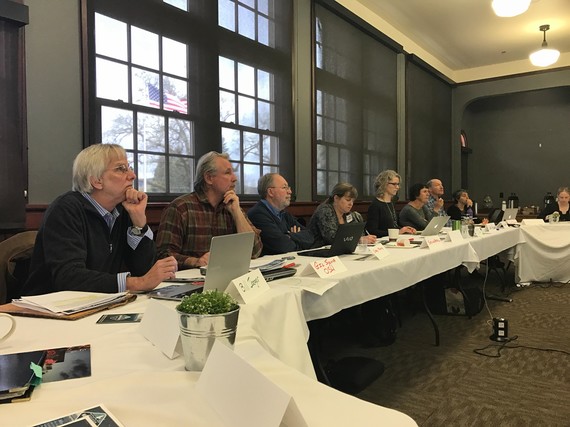Banking on Baby Fish and Big Data
Shake, shake, shake. On the deck of a boat a mile from shore, a biologist shakes a tubular role of green plastic mesh, called a SMURF. It's just been pulled out of the ocean. Another biologist, wetsuit clad with a snorkel mask pushed up onto her forehead, pours water over the mesh tube.
As the rhythmic shaking and pouring continues, all eyes are trained on the mesh bag in anticipation. Shake, shake. Pour.
Suddenly, several tiny fish fall from the SMURF onto a net spread below. They are baby Cabezon, likely only a few months old.
Juvenile fish data collected during our SMURF surveys was recently provided to stock assessors for the 2019 Cabezon stock assessment. Currently, the marine reserves monitoring program is the only program collecting these juvenile fish data in Oregon. Read more about why stock assessments are important and how our data was used.
 A harbor seal with a satellite transmitter. Satellite transmitters give researchers an idea of harbor seal home ranges and their use of nearby marine reserves. Photo Credit: Dr. Shea Steingass.
While thousands of harbor seals call the Oregon Coast home, how far and where they typically venture isn’t well known. During her graduate research at OSU’s Marine Mammal Institute, Shea Steingass tracked seal movements and described their use of the Oregon coast, including their use of nearby marine reserve sites.
Small satellite transmitters were adhered atop the heads of 24 harbor seals at two haulout sites on the Central Oregon coast. Researchers learned that the average home range for each seal is 141 square miles, and each animal was likely to spend a majority of their time in an area of about 12 square miles. When seals take to the open ocean, their trips last about 22 hours on average.
The research revealed that harbor seals rarely spent much time within Oregon’s marine reserves. However, the highly productive area of Heceta Bank, including Cape Perpetua Marine Reserve was within the daily reach of animals hauling out in Alsea Bay and proved to be important locations for some animals. Seals traveled widely on the continental shelf north of Cape Blanco.
Shea was a recipient of our 2016 ODFW Marine Reserves Graduate Student scholarship, which helped support her research. Dr. Shea Steingass now leads the Marine Mammal Program at ODFW.
More information about the study can be found in the journal PLOS ONE.
UPCOMING STAC MEETING
 The Scientific and Technical Advisory Committee (STAC) will be meeting remotely on Thursday, August 29th, 2019 from 9:00AM to 12:00PM. This will be a virtual meeting. The agenda and information about how to join is available here. STAC will be continuing discussions on planning for the 2023 Marine Reserves Program evaluation.
 Tuesday morning SCUBA research at Redfish Rocks Marine Reserve. The red dive flag means scientific divers are underwater counting algae, invertebrate and fish communities. They survey 60 meter transects counting observed organisms and noting the type of habitat they encounter. Fish sizes are estimated and species densities are also calculated.
 |
|
Fall hook-and-line surveys are starting this week, with hook-and-line/longline research at Redfish Rocks Marine Reserve. We will head to Cape Falcon Marine Reserve in early September. |
 |
|
In the fall, underwater visibility begins to improve and SCUBA surveys are able to start back up again. This week, scientific divers are doing surveys at Redfish Rocks Marine Reserve. |
 |
|
We did a data downloaded from our oceanographic sensor at Cascade Head. The sensor is tracking temperature, salinity, and oxygen levels every hour of the day over the next few months. This information is helping us understand nearshore oceanographic conditions at Cascade Head, such as if and when hypoxic (low oxygen) conditions occur and how long they last. |
 |
|
Two intertidal sea star surveys were completed at Otter Rock and Cascade Head. |
UPDATES FROM COLLABORATORS
 Two weeks ago, this year's first juvenile tiger rockfish showed up in a SMURF. Juvenile tiger rockfish typically start showing up this time of year.
 |
|
We continued collecting samples from SMURFs set out at Otter Rock as part of juvenile fish recruitment surveys, led by Oregon State University and in collaboration with the Oregon Coast Aquarium. This year's first juvenile tiger rockfish was spotted about two weeks ago in a SMURF (photo above). SMURF surveys will be continuing through the fall. |
Explore More Marine Reserves News
|